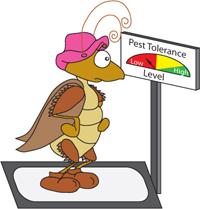Decision Making Using Pest Tolerances
There are several important inputs into a decision-making process. Decision making is based largely on pest tolerance levels. Other factors such as site analysis, potential control methods, and safety concerns also play an important part.
 Establishing a pest-tolerance level is the first step in pest management decision making. A single insect in a building or a cropping system seldom warrants a treatment, but a large number of pests might. That is why assessing the size of the pest populationthe number of pests per building, per plant, per acre, or per animalis so important. However, it is also true that all pests are not created equal; some pests may be potentially much more damaging than others. Both a termite and an ant may be pests, but while an ant is a nuisance, a termite can cause structural damage to a home, so the termite is the more significant pest. In this case, one termite is more troublesome than a colony of ants. Thus, the potential for a pest to cause damage must be assessed in order to determine if and when the pest must be managed.
The likelihood that a pest will cause damage, or pest potential, must be a part of the IPM decision-making process.
The estimated number of pests (population size) usually can be an indicator of the amount of damage to be expected. Think of it as this equation:
Pest population size = amount of potential damage
Therefore, an estimate of the damage potential can also substitute for the pest population size. Either of these estimates can be used to determine a pest-tolerance level, which is the maximum amount of damage or the maximum number of pests that can be tolerated in any particular situation.
For example, a person may be able to live with, or tolerate, three flies in a home, but any more than that will make them uncomfortable. In this case, the tolerance level is set at three. Another example might allow 500 grasshoppers per acre as acceptable in a grass pasture, but when the population exceeds 500, the pasture begins to sustain serious damage.
The following graph depicts the relationship between population size or damage potential and pest tolerance:
As the pest population increases, it may eventually reach a point where it is intolerable. That intersection is considered the tolerance threshold.
This is the point at which controls must be in place to reduce or maintain the population.
Integrated pest management is not geared toward complete eradication of a pest. The goal is to maintain the pest population below the level of pest tolerance. Depending on the system, the tolerance level may be a function of economics, aesthetics, or human health and comfort. Tolerance levels depend upon the system for which they are calculated. The tolerance threshold concept in IPM was developed for agricultural pest management, but it also applies to turf, landscape, and structural IPM. Each system has a different goal that will determine the number of pests that can be tolerated. In agriculture, the management goal is typically to maximize profit by producing the highest yield with the least production costs, including pesticide application expenses. In turf and landscapes, the management goal is generally to maintain a pleasing appearance in an economically reasonable way. In buildings, the goal is to prevent pests from threatening human health and peace of mind, or harming contents or structures. In all of these systems, the pest manager must determine the level of pest population that can be tolerated without having a negative impact on the systems management goal.
 Establishing a tolerance threshold is a simple concept in theory. However, in practice it is more difficult to establish and may vary, depending upon several factors. Consider, for example, that:
- Not all pests represent an equal threat.
- Not all environments, people or plants are equally sensitive
- Pests may be more damaging under certain conditions than others
Factors Influencing Tolerance Levels
|
